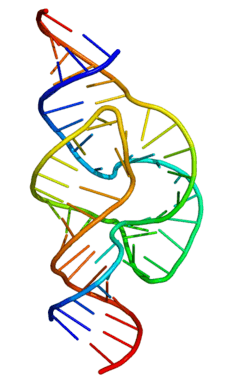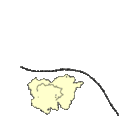Ribozyme facts for kids
A ribozyme (ribonucleic acid enzyme) is an RNA molecule that can help certain biochemical reactions. similar to the action of protein enzymes.
Also called catalytic RNA, ribozymes work in the ribosome to link amino acids during protein synthesis. They also take part in RNA splicing, viral replication, and transfer RNA biosynthesis.
The 1981 discovery of ribozymes showed RNA can be both genetic material (like DNA) and a biological catalyst (like enzymes). This led to the RNA world hypothesis, in which RNA acts in the evolution of prebiotic self-replicating systems.
Investigators studying the origin of life have produced ribozymes in the laboratory that can catalyze their own synthesis under certain conditions, such as an RNA polymerase ribozyme. Improved variants of the "Round-18" polymerase ribozyme have been developed. "B6.61" is able to add up to 20 nucleotides to a primer template in 24 hours, until it decomposes by cleavage of its phosphodiester bonds. The "tC19Z" ribozyme can add up to 95 nucleotides with great accuracy.
Some ribozymes may play an important role as therapeutic agents, as enzymes which target defined RNA sequences for cleavage, as biosensors, and for applications in genomics and gene discovery.
History
In 1967, Carl Woese, Francis Crick, and Leslie Orgel suggested that RNA could act as a catalyst. It was discovered that RNA can form complex secondary structures.
The first ribozymes were discovered in the 1980s. In 1989, Thomas Cech and Sidney Altman won the Nobel Prize in Chemistry for their "discovery of catalytic properties of RNA".
Images for kids
-
A ribosome is a biological machine that utilizes a ribozyme to translate RNA into proteins
See also
 In Spanish: Ribozima para niños
In Spanish: Ribozima para niños




